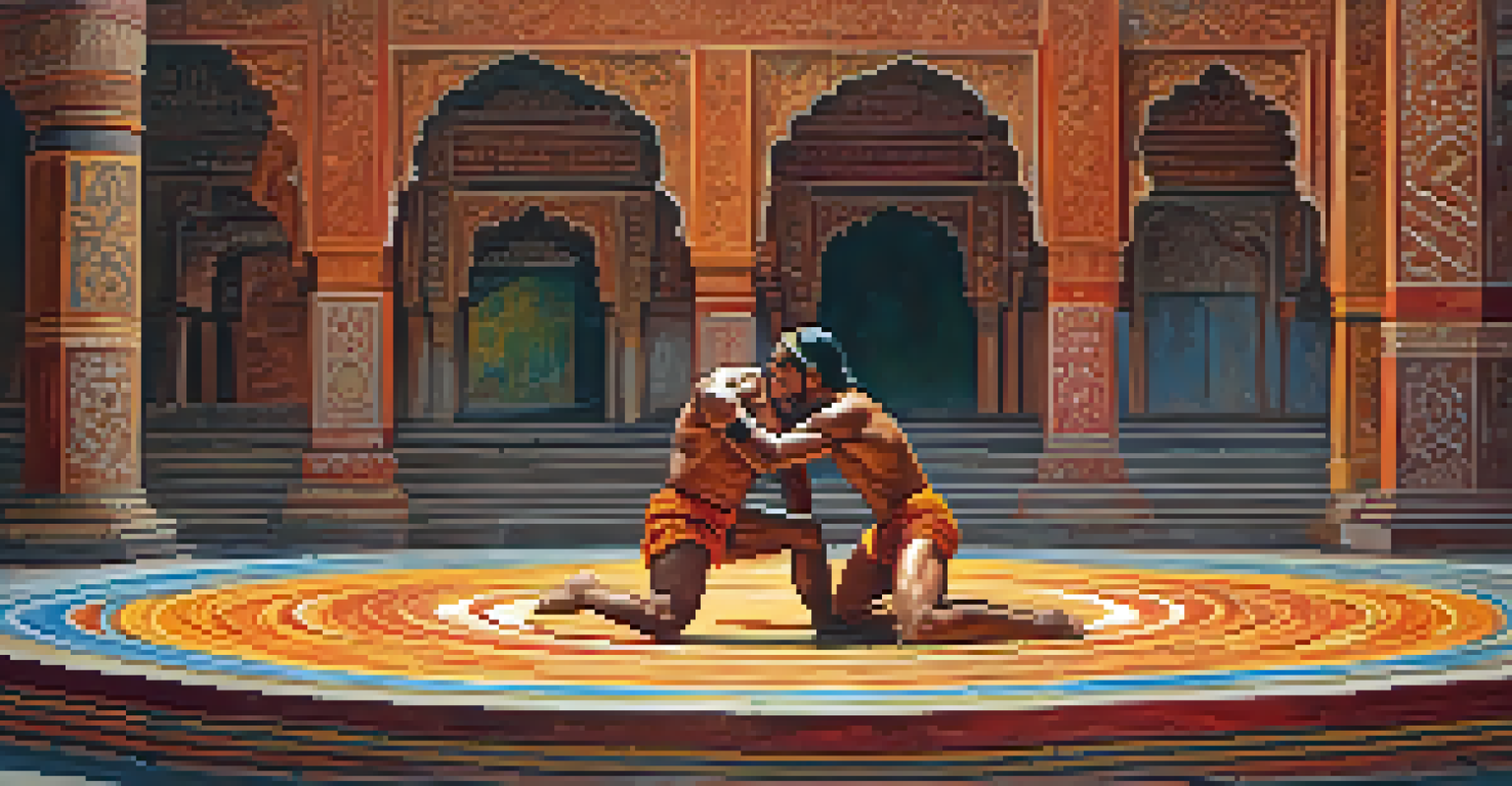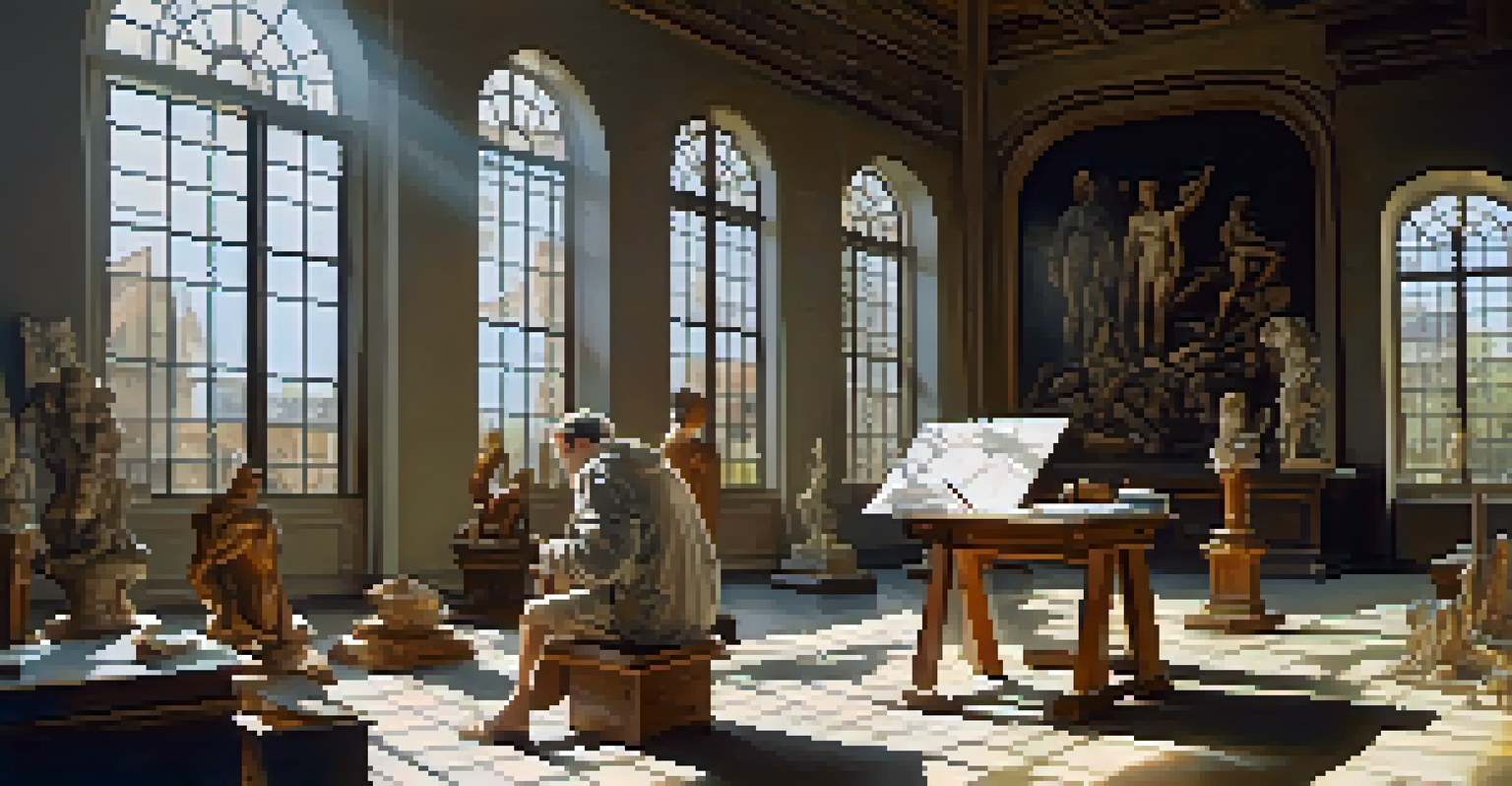The Origins of Bodybuilding: Ancient Practices and Beliefs

Understanding Bodybuilding's Historical Roots
Bodybuilding, as we know it today, has deep historical roots that span centuries. Its origins can be traced back to ancient civilizations where physical strength was not just admired but revered. These societies viewed the human body as a vessel of power, beauty, and health, laying the groundwork for modern bodybuilding practices.
The body is a temple, and I treat it with the utmost respect.
In ancient Greece, for example, athletes would train rigorously for competitions like the Olympics, showcasing their muscular physiques as symbols of excellence. The Greeks believed that physical fitness was directly linked to mental prowess and spiritual well-being, highlighting the holistic approach to body development that would influence future generations.
Similarly, in ancient India, practices like 'Malla Yuddha' or wrestling were not only sports but also a means of developing strength and discipline. This blend of physical culture and spiritual practices showcased the early understanding of the importance of body and mind, a concept that continues to resonate in today's fitness community.
Ancient Greece: The Birthplace of Athletic Culture
The Olympic Games, first held in 776 BC, marked a significant milestone in the history of bodybuilding. Athletes from various city-states would gather to compete, emphasizing not only athletic skill but also the aesthetic appeal of the human body. Sculptors of the time captured these idealized forms in marble, expressing society's admiration for physical perfection.

Training regimens in ancient Greece included a mix of weightlifting, running, and wrestling, designed to enhance strength and endurance. These methods laid the foundation for what we now recognize as bodybuilding workouts, where the goal is to sculpt and define the body through targeted exercises.
Bodybuilding's Ancient Foundations
The practice of bodybuilding has deep historical roots in ancient civilizations, where physical strength was revered and linked to overall well-being.
Moreover, the Greeks believed in the concept of 'kalokagathia,' which embodies the idea that physical beauty and moral virtue are intertwined. This philosophy influenced their approach to fitness, encouraging not just muscle gain but the development of character and ethics through physical training.
Ancient Egypt: Strength and Spirituality
In ancient Egypt, physical strength held a dual significance, intertwining with spirituality and daily life. The Egyptians engaged in various physical activities, including wrestling and weightlifting, which were often depicted in their art and hieroglyphs. These practices were not merely for entertainment; they were believed to prepare individuals for the afterlife, underscoring the importance of a strong, healthy body.
Strength does not come from physical capacity. It comes from an indomitable will.
The ancient Egyptians also had a unique perspective on balance and harmony, reflecting their belief that a fit body contributed to a harmonious life. This holistic view of health emphasized not just physical strength but also mental and emotional well-being, a principle that many modern bodybuilders still embrace.
Additionally, physical prowess was often associated with the gods, particularly in the context of warriors and pharaohs. This connection between strength and divinity reinforced the idea that cultivating one's body was a noble pursuit, worthy of respect and admiration.
The Role of Ancient India in Bodybuilding's Evolution
Ancient India contributed significantly to the evolution of bodybuilding through practices like yoga and martial arts. The holistic approach of yoga emphasized the union of mind, body, and spirit, focusing on strength, flexibility, and endurance. This philosophy made its way into various forms of physical training, influencing the development of bodybuilding techniques.
Malla Yuddha, or wrestling, was another ancient practice that highlighted the importance of strength and conditioning. Wrestlers would engage in rigorous training, often using bodyweight exercises and traditional tools like stone and wooden weights, akin to modern resistance training methods.
Influence of Ancient Cultures
Ancient Greece, Rome, and India significantly shaped bodybuilding through their unique approaches to physical training, aesthetics, and the mind-body connection.
The principles of discipline and focus in these ancient practices continue to resonate with bodybuilders today, showcasing the timeless connection between physical training and mental fortitude. This rich heritage reminds us that bodybuilding is not just about aesthetics but also about cultivating a strong and resilient character.
The Influence of Ancient Rome on Bodybuilding
In ancient Rome, strength training became an integral part of military preparation and public entertainment. Gladiators, who were often celebrated for their physical prowess, underwent rigorous training to build impressive physiques that could withstand the rigors of combat. Their training routines, which included lifting heavy weights and practicing combat skills, laid the groundwork for modern bodybuilding.
Roman culture revered the muscular form, as seen in their sculptures and public artworks, which often depicted athletes and heroes in idealized poses. This admiration for the human body encouraged citizens to engage in physical activities, promoting a culture that celebrated strength and fitness.
Moreover, the Romans introduced various forms of competitive sports and public games, further embedding physical fitness into the fabric of society. This focus on athletic competition and the sculpting of the body contributed to the legacy of bodybuilding, influencing future generations of fitness enthusiasts across the globe.
The Renaissance: Reviving the Bodybuilder's Ideal
The Renaissance marked a significant revival of interest in the human body, blending art, science, and physical culture. Artists like Michelangelo and Leonardo da Vinci studied anatomy and proportions, creating works that celebrated the beauty of the human form. This period fostered an appreciation for muscular physiques, which would later influence the ideals of bodybuilding.
During this time, physical fitness began to be seen as essential for overall well-being. The concept of the 'ideal body' emerged, prompting individuals to engage in activities that would enhance their strength and appearance. This shift laid the groundwork for organized bodybuilding practices that we see today.
Modern Bodybuilding's Evolution
Today's bodybuilding combines ancient practices with contemporary techniques, emphasizing a holistic approach to fitness and personal growth.
Additionally, the Renaissance encouraged the pursuit of knowledge about health and fitness, leading to the development of early exercise regimens. These practices set the stage for the modern fitness movement, as people sought to emulate the strong, aesthetically pleasing bodies depicted in art and literature.
Modern Bodybuilding: A Synthesis of Ancient Practices
Today, bodybuilding is a multifaceted discipline that draws inspiration from its ancient roots while incorporating contemporary techniques. Modern bodybuilders often combine weightlifting, nutrition, and recovery strategies, creating a comprehensive approach to physical fitness. This evolution reflects the ongoing journey of bodybuilding as a practice that transcends time and culture.
The resurgence of interest in health and fitness has led to a greater understanding of the body’s potential, encouraging individuals to embrace their unique fitness journeys. This inclusivity resonates with the ancient belief that physical strength is a vital aspect of a well-rounded life, promoting both personal growth and community.

As we look back at the origins of bodybuilding, it becomes clear that this practice is more than just a pursuit of muscle gain; it's a celebration of the human spirit and its capacity for growth. By understanding and honoring these ancient practices, modern bodybuilders can cultivate a deeper connection to their physical training and the rich history that precedes them.